Swing Dance News
hep to the jive
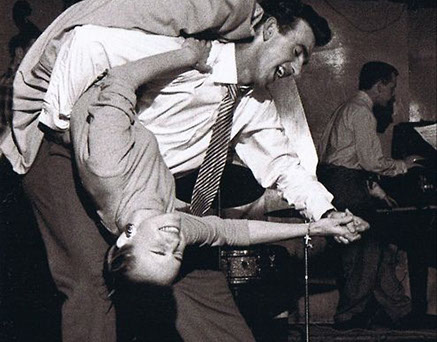
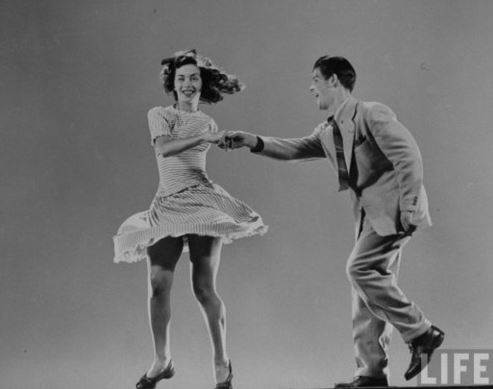
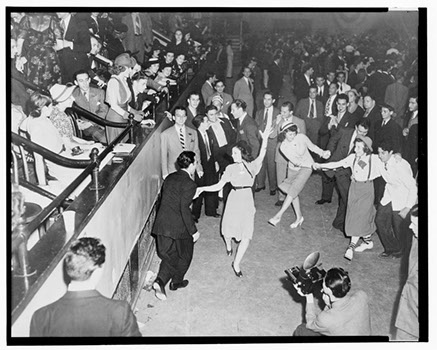
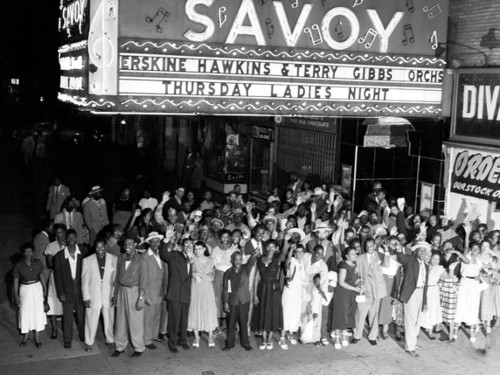
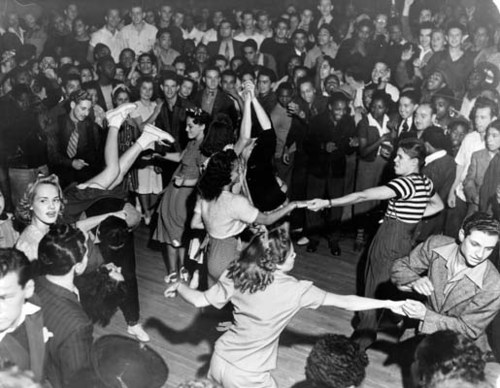
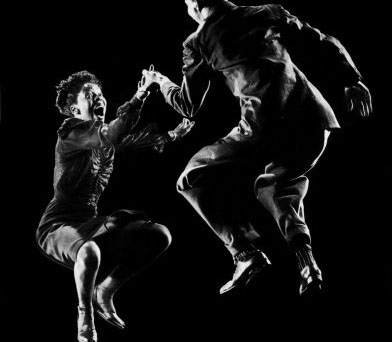
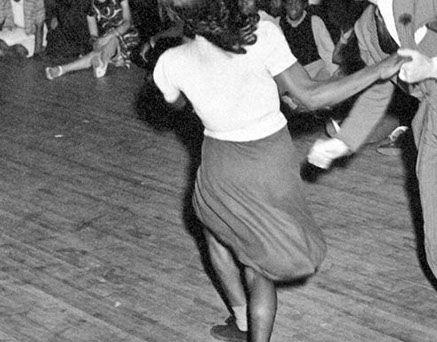
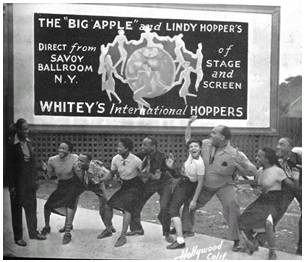
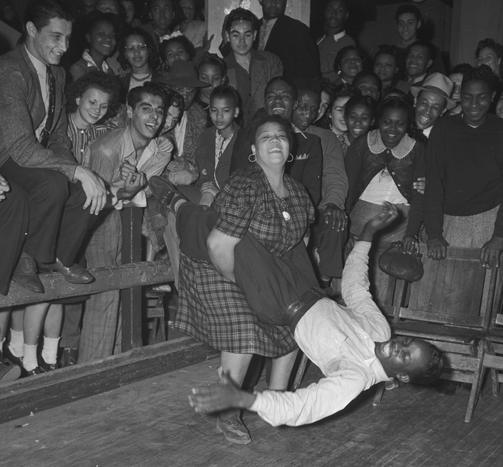
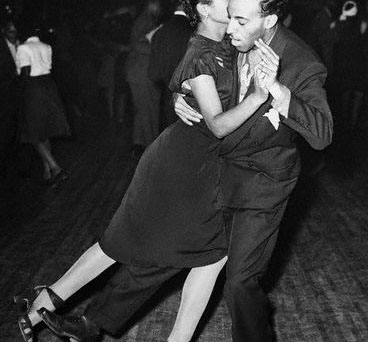
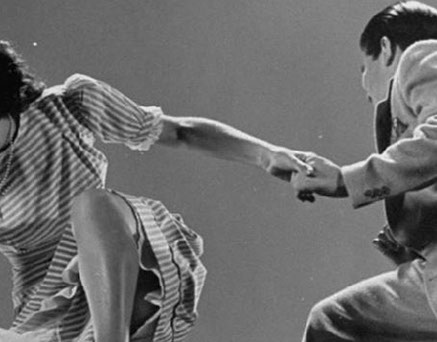
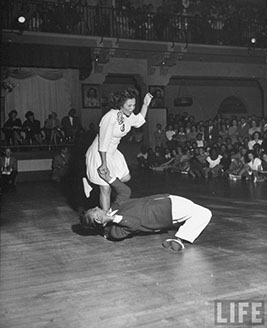
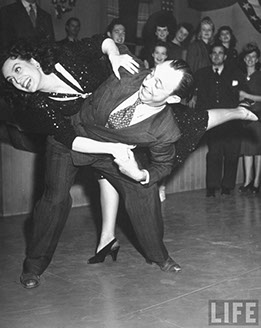
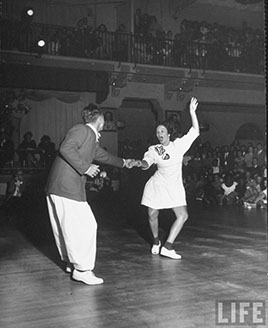
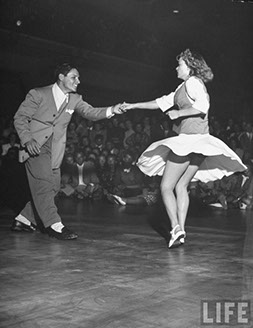
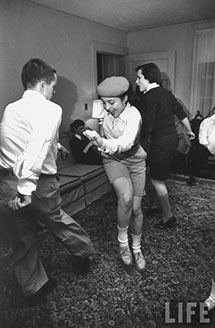
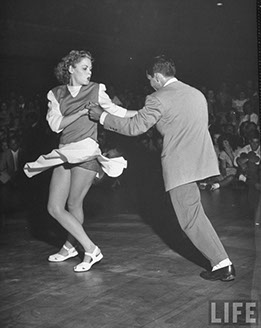
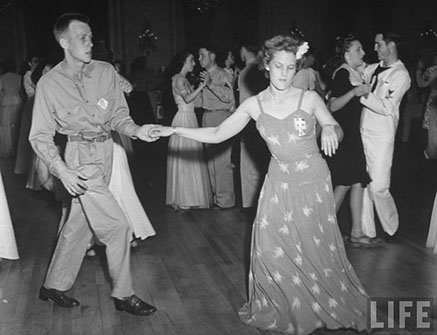



|<<
<
>
History of Swing
Competition and Performance
Competition and Performance2
Styles of Swing
Sources: Lori Heikkila, Wikipedia, Lindy Hop Archives
The term "swing dance" is commonly used to refer to a group of dances developing in response to American swing music in the 1920s, 30s and 40s, or to lindy hop, a popular partner dance today. Swinging jazz music features a combination of crotchets and quavers which many swing dancers interpret as 'triple steps' and 'steps' - yet also introduces changes in the way these rhythms were played - a distinct delay or 'relaxed' approach to timing.
The Savoy Ballroom opened its doors in Harlem, New York on March 26, 1926. The Savoy was an immediate success with its block-long dance floor and a raised double bandstand. Nightly dancing attracted most of the best dancers in the New York area of every race.
One evening in 1926, following Lindbergh's flight to Paris, a local dance enthusiast named "Shorty George" Snowden was watching some of the dancing couples. A newspaper reporter asked him what dance they were doing, and it just so happened that there was a newspaper with an article about Lindbergh's flight sitting on the bench next to them. The title of the article read, "Lindy Hops The Atlantic," and George just sort of read that and said, "Lindy Hop" and the name stuck.
In the mid 1930's, a bouncy six beat variant was named the Jitterbug by the band leader Cab Calloway when he introduced a tune in 1934 entitled
"Jitterbug". With the discovery of the Lindy Hop and the Jitterbug, the communities began dancing to the contemporary Jazz and Swing music as it was evolving at the time, with Benny Goodman leading the action. Dancers soon incorporated tap and jazz steps into their dancing. Herbert White, head bouncer in the New York City Savoy Ballroom formed a Lindy Hop dance troupe called Whitey's Lindy Hoppers. Two of the most influential members of Whitey's Lindy Hoppers are Frankie "Musclehead" Manning and Norma Miller. Whitey's Lindy Hoppers were showcased in the following films: "A Day at the Races" (1937), "Hellzapoppin" (1941), "Sugar Hill Masquerade" (1942), and "Killer Diller" (1948).
In 1938, the Harvest Moon Ball included Lindy Hop and Jitterbug competition for the first time. It was captured on film and presented for everyone to see in the Paramount, Pathe, and Universal movie newsreels between 1938 and 1951.
In early 1938, Dean Collins arrived in Hollywood. He learned to dance the Lindy Hop, Jitterbug, Lindy and Swing in New York City and spent a lot of
time in Harlem and the Savoy Ballroom. Between 1941 and 1960, Collins danced in, or helped choreograph over 100 movies which provided at least a 30 second clip of some of the best California white dancers performing Lindy Hop, Jitterbug, Lindy and Swing.
In the late 1930's and through the 1940's, the terms Lindy Hop, Jitterbug, Lindy, and Swing were used interchangeably by the news media to describe the same style of dancing taking place on the streets, in the night clubs, in contests, and in the movies.
By the end of 1936, the Lindy was sweeping the United States. As might be expected, the first reaction of most dancing teachers to the Lindy was a
chilly negative. In 1936 Philip Nutl, president of the American Society of Teachers of Dancing, expressed the opinion that swing would not last
beyond the winter. In 1938 Donald Grant, president of the Dance Teachers' Business Association, said that swing music "is a degenerated form of
jazz, whose devotees are the unfortunate victims of economic instability."
In 1942 members of the New York Society of Teachers of Dancing were told that the jitterbug (a direct descendent of the Lindy Hop), could no longer be ignored. Its "cavorting" could be refined to suit a crowded dance floor.
The dance schools such as The New York Society of Teachers and Arthur Murray, did not formally begin documenting or teaching the Lindy Hop,
Jitterbug, Lindy, and Swing until the early 1940's. The ballroom dance community was more interested in teaching the foreign dances such as the
Argentine Tango, Spanish Paso Doblé, Brazilian Samba, Puerto Rican Merengue, Cuban Mambo and Cha Cha, English Quickstep, Austrian Waltz, with an occasional American Fox-trot and Peabody.
In the early 1940's the Arthur Murray studios looked at what was being done on the dance floors in each city and directed their teachers to teach
what was being danced in their respective cities. As a result, the Arthur Murray Studios taught different styles of undocumented Swing in each city.
In the early 1940's, Lauré Haile, as a swing dancer and competitor, documented what she saw being danced by the white community. At that time,
Dean Collins was leading the action with Lenny Smith and Lou Southern in the night clubs and competitions in Southern California. Lauré Haile gave it the name of "Western Swing". She began teaching for Arthur Murray in 1945. Dean Collins taught Arthur Murray teachers in Hollywood and San Francisco in the late 1940's and early 1950's.
After the late 1940's, the soldiers and sailors returned from overseas and continued to dance in and around their military bases. Jitterbug was
danced to Country-Western music in Country-Western bars, and popularized in the 1980's.
As the music changed between the 1920's and 1990's, (Jazz, Swing, Bop, Rock 'n' Roll, Rhythm & Blues, Disco, Country), the Lindy Hop, Jitterbug,
Lindy, and Swing evolved across the U.S. with many regional styles. The late 1940's brought forth many dances that evolved from Rhythm & Blues music: the Houston Push and Dallas whip (Texas), the Imperial Swing (St. Louis), the D.C. Hand Dancing (Washington), and the Carolina Shag
(Carolinas and Norfolk) were just a few.
In 1951 Lauré Haile first published her dance notes as a syllabus, which included Western Swing for the Santa Monica Arthur Murray Dance Studio. In the 50's she presented her syllabus in workshops across the U.S. for the Arthur Murray Studios. The original Lauré Haile Arthur Murray Western
Swing Syllabus has been taught by Arthur Murray studios with only minor revisions for over 50 years.
From the mid 1940's to today, the Lindy Hop, Jitterbug, Lindy, and Swing, were stripped down and distilled by the ballroom dance studio teachers in order to adapt what they were teaching to the less nimble-footed general public who paid for dance lessons. As a result, the ballroom dance studios bred and developed a ballroom East Coast Swing and ballroom West Coast Swing.
In the late 1950's, television brought "American Bandstand", "The Buddy Dean Show" and other programs to the teenage audiences. The teenagers were rocking with Elvis Presley, Little Richard, and Chuck Berry leading the fray. In 1959, some of the California dance organizations, with Skippy
Blair setting the pace, changed the name of Western Swing to West Coast Swing so it would not be confused with country and western dancing.
In the 1990's, dancers over 60 years of age were still moving their Lindy Hoppin', Jitterbuggin', Swingin', and Shaggin' feet.
Today there are swing dance scenes in many developed Western and Asian countries throughout the world, and though each city and country varies in their preferences for particular dances, lindy hop is often the most popular. Each local swing dance community has a distinct local culture and defines "swing dance" and "appropriate" dance music in different ways.
Traditionally, distinctions are made between "Ballroom Swing" and "Street Swing" styles. East Coast Swing is a standardized dance in "American Style" Ballroom dancing , whereas Jive is a standardized dance in "International Style" . Street forms (evolved in dance halls) vs. Standardized forms (created for competition) are different in appearance. Standardized forms are danced in competition usually choreographed or done strictly in established patterns. Street forms are danced in many different styles and places with thousands of differences and are very open to interpretation and creative evolutions. However, any dancing that does not preserve lead/follow dynamics and/or focus on stylization and aesthetics instead of partnership and improvisation are Competition/Exhibition in nature. An example of a form that is purely Competition/Exhibition is Acrobatic Rock & Roll.
Social swing dancing
Many, if not most, of the swing dances listed above are popular as social dance, with vibrant local communities that hold dances with DJs and live bands that play music most appropriate for the preferred dance style. There are frequently active local clubs and associations, classes with independent or studio/school-affiliated teachers and workshops with visiting or local teachers. Most of these dance styles - as with many other styles - are also featured by special events such as camps, exchanges, or large event such as conventions. An example of a popular national swing dance convention is Swing Dance USA.
Music
The historical development of particular swing dance styles was often in response to trends in popular music. Charleston, for example, was - and is - usually danced to 2/4 ragtime music, Lindy Hop was danced to swing music, which is a kind of swinging jazz. West Coast Swing a modern evolution of Lindy Hop is usually danced to Pop, R&B, Blues, or Funk. Country & Western Swing, Push/Whip, and Pony swing are usually danced to country and western music. Hip hop lindy is danced to hip hop music, and blues dancing either to historical blues music forms, or to slower music from a range of genres (though most frequently to jazz or blues). There are local variations on these associations in each scene, often informed by the local DJ's, dance teachers and bands.
In many scenes outside the United States the term "Swing dancing" is used to refer generically to one or all of the following swing era dances: Lindy Hop, Charleston, Shag, Balboa and Blues. This group is often extended to include Jive, Rock and Roll, Western Swing, and other dances developing in the 1940s and later. Within the United States, the swing dance family is often expanded to include many other social dances, including West Coast Swing, East Coast Swing, Hand Dancing, and so on. A strong tradition of social and competitive boogie woogie and acrobatic rock and roll in Europe add these dances to their local swing dance cultures. In Singapore and other scenes, Latin dances such as salsa and Tango are often taught and danced within the "Swing scene", and for many scenes tap dancing and a range of other jazz dances are considered key, as are hip hop and other contemporary African American street dances. The variations continue, dictated by local dance community interests.
Many swing dancers today argue that it is important to dance many styles of partner dance to improve technique, but also to reflect the historical relationship between these dances in the swing era of the 1920s and 1930s. In the Savoy Ballroom, for example, bands would often play waltzes, Latin songs and so on, as well as swinging jazz. Dancers were often familiar with a wide range of popular and traditional dances. There are a number of hybrid forms which combine swing dances with other styles, including Swango, a combination of Argentinean Tango and Swing.
Later forms from the 1930s and 1940s
Lindy Hop evolved in the late 1920s and early 1930s and is claimed to be the original swing dance. It is characterized by an emphasis on improvisation and the ability to easily adapt to include steps from other 8-count and 6-count Swing styles. It has been danced to most every conceivable form of jazz music, as well as to the blues, and any other type of music with a blues or jazz rhythm.
Balboa is an 8-count dance that emphasizes a strong partner connection and quick footwork. A product of Southern California's crowded ballrooms, Balboa (or "Bal") is primarily danced in a tight, closed position with the follow and lead adopting a firm chest-to-chest posture. Over time, enthusiasts created a library of open moves, called Bal-Swing. While most dancers differentiate between Balboa and Bal-Swing, both are considered to be part of the dance. Balboa is frequently danced to fast jazz (usually anything from 180 to 320 beats per minute), though many like to Balboa to slower tempos.
Blues dancing today is an informal type of dance with no fixed patterns and a heavy focus on connection, sensuality and improvisation, often with strong body contact. Although usually done to blues music, it can be done to any slow tempo 4/4 music, including rock ballads and "club" music. Historically, there are many different types of blues dancing, including the slow drag. While not technically a "swing dance", Blues is historically/culturally related to Swing and remains popular in some swing dance communities.
Other swing related dances:
Carolina shag
Collegiate shag
St. Louis shag
Forms from the 1940s, 50s and later
Boogie-woogie developed originally in the 1940s with the rise of boogie woogie music. It is popular today in Europe, and is considered by some to be the European counterpart to East Coast Swing, a Six count dance standardized for the American ballroom industry. It is danced to rock music of various kinds, blues or boogie woogie music but usually not to jazz.
Western Swing, also called Country Swing or Country/Western Swing (C/W Swing) is a form with a distinct culture. It resembles East Coast Swing, but adds variations from other country dances. It is danced to country and western music.
Eastern Swing is an evolution of Fox Trot and the precursor to the more modern East Coast Swing.
East Coast Swing is a simpler 6-count variation. It is also known as Single-Time Swing, Triple-Step Swing, 6-Count Swing, Rock-a-billy, or Jitterbug. East Coast Swing has very simple structure and footwork along with basic moves and styling. It is popular for its forgiving yet elegant nature, and it is often danced to slow, medium, or fast tempo swing, jazz, jump blues, or rock and roll.
St Louis Imperial Swing Dancing The dance is a cross between East Coast and West coast as it is done in slot and in the round. It started at the "Club Imperial" in St Louis. George Edick, who owned the club, let teenagers dance in the lower level and the swing dancers of the time taught them what was learned from their trips to the east coast. As people traveled around they added parts of west coast, bop and Carolina shag to complement the dance and make it distinctive. People can tell the difference between St Louis dancers from dancers from other parts of the country. "The Imperial" has elements of "East Coast", West Coast", "Carolina Shag", and "Bop".
Washington Hand Dancing
Jive is a dance of International Style Ballroom dancing. It initially was based on Eastern swing brought to England by Americans Troops in WWII and evolved before becoming the now standardized form of today.
Push and Whip are Texas forms of swing dance.
Skip jive A British variant, popular in the 50s and 60s danced to traditional jazz.
West Coast Swing was developed in the 1940s and 1950s as a stylistic variation on Lindy Hop. Followers stay in a slot, which reduces their ability to move left and right but improves their ability to spin left and right. West Coast Swing is often danced with blues and rock and roll music, as well as to smooth and cool jazz. It is popular throughout the United States and Canada but is uncommon in Australia, New Zealand and much of Asia, though it is often compared to Ceroc or Dirty Latin Jive in these countries.
Acrobatic Rock and Roll Popular in Europe, acrobatic rock and roll is popularly associated with Russian gymnasts who took up the dance, though it is popular throughout Europe today. It is more a performance dance and sport than a social dance.
Rock and roll - Developing in the 1950s in response to rock and roll music, rock and roll is very popular in Australia and danced socially as well as competitively and in performances. The style has a long association with Lindy Hop in that country, as many of the earliest lindy hoppers in the early 1990s moved to Lindy Hop from a rock and roll tradition. Many of the older lindy hoppers are also keen rock and roll dancers, with rock and roll characterized by an older dancer (30s and older) than Lindy Hop (25 and under).
Modern Jive - also known as LeRoc and Ceroc - developed in the 1980's, reputedly from a French form of Jive.